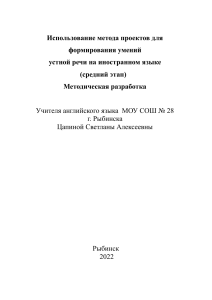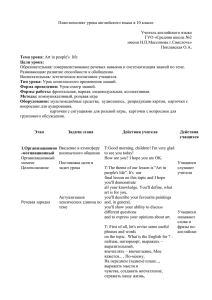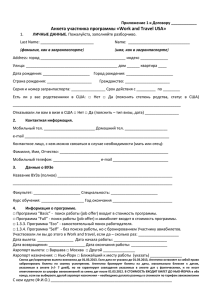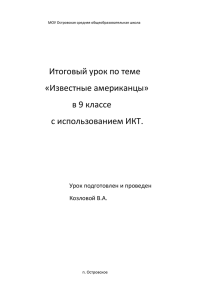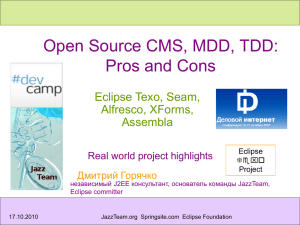В основе проекта идея:
реклама
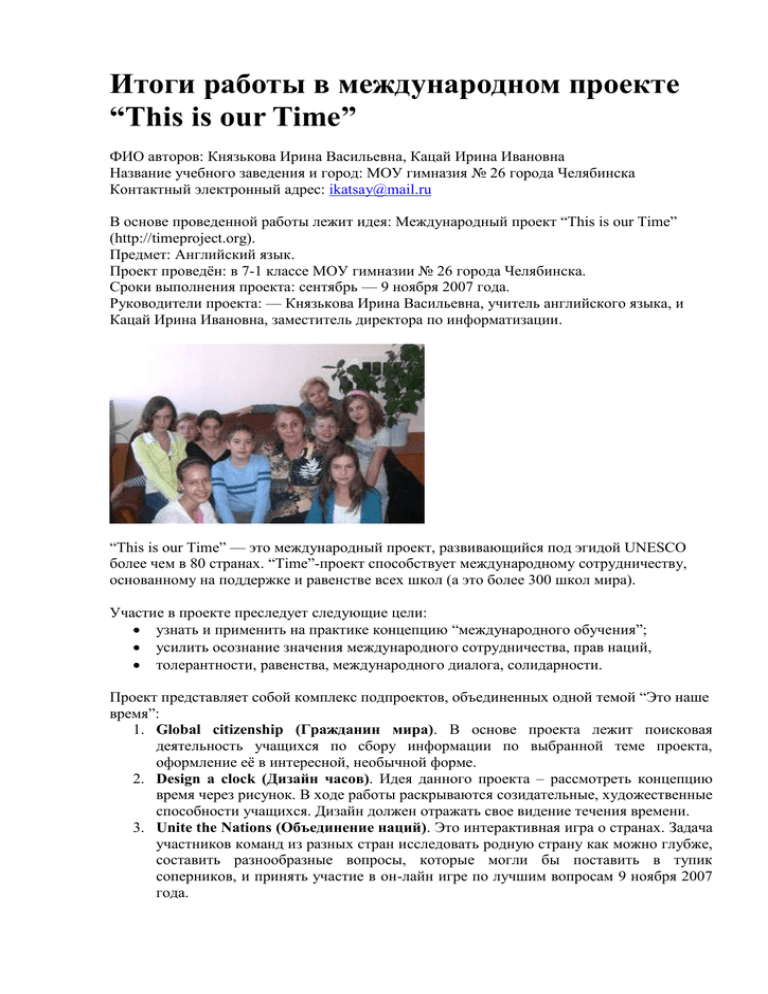
Итоги работы в международном проекте “This is our Time” ФИО авторов: Князькова Ирина Васильевна, Кацай Ирина Ивановна Название учебного заведения и город: МОУ гимназия № 26 города Челябинска Контактный электронный адрес: [email protected] В основе проведенной работы лежит идея: Международный проект “This is our Time” (http://timeproject.org). Предмет: Английский язык. Проект проведён: в 7-1 классе МОУ гимназии № 26 города Челябинска. Сроки выполнения проекта: сентябрь — 9 ноября 2007 года. Руководители проекта: — Князькова Ирина Васильевна, учитель английского языка, и Кацай Ирина Ивановна, заместитель директора по информатизации. “This is our Time” — это международный проект, развивающийся под эгидой UNESCO более чем в 80 странах. “Time”-проект способствует международному сотрудничеству, основанному на поддержке и равенстве всех школ (а это более 300 школ мира). Участие в проекте преследует следующие цели: узнать и применить на практике концепцию “международного обучения”; усилить осознание значения международного сотрудничества, прав наций, толерантности, равенства, международного диалога, солидарности. Проект представляет собой комплекс подпроектов, объединенных одной темой “Это наше время”: 1. Global citizenship (Гражданин мира). В основе проекта лежит поисковая деятельность учащихся по сбору информации по выбранной теме проекта, оформление её в интересной, необычной форме. 2. Design a clock (Дизайн часов). Идея данного проекта – рассмотреть концепцию время через рисунок. В ходе работы раскрываются созидательные, художественные способности учащихся. Дизайн должен отражать свое видение течения времени. 3. Unite the Nations (Объединение наций). Это интерактивная игра о странах. Задача участников команд из разных стран исследовать родную страну как можно глубже, составить разнообразные вопросы, которые могли бы поставить в тупик соперников, и принять участие в он-лайн игре по лучшим вопросам 9 ноября 2007 года. Учащиеся выбирали тему и форму участия в проекте самостоятельно. Были сформирована мини-группы для работы, часть детей предпочли работать индивидуально. 30 октября 2007 года все работы учащихся были отправлены в штаб-квартиру организаторов проекта в Нидерланды. 2 ноября 2007 года бы получен ответ, что все проекты одобрены и размещены на сайте (http://timeproject.org). Защита работ учащимися проводилась на открытом уроке. Ученики на английском языке комментировали свои проекты, рассказывали об этапах своей работы, о преодолении трудностей. Заключительный этап работы будет проходить в феврале 2008 года. Результаты будут опубликованы на сайте проекта. Global citizenship Особенности реализации проекта В основе проекта лежит поисковая деятельность учащихся по сбору информации по выбранной теме проекта, оформление её в интересной, необычной форме, отправление проектов на сайт «Time» через электронную почту. Ход выполнения проекта Первый этап — «Мозговой штурм» 1. Ознакомление с правилами игры через Интернет. 2. Формирование инициативных групп. 3. Выбор темы проекта. В нашем случае учащиеся выбрали: a. История Кировки (одной из главных достопримечательностей города). b. Время течёт, но память остаётся (история памятников в Челябинске). c. Уральские чудеса природы (Аркаим, Кунгурские пещеры). 4. Стихотворение на английском языке «Весна на Урале». 5. Обсуждение с учащимися возможных источников нахождения информации (книги, музеи, Интернет). 6. Разработка плана действий. Второй этап – Самостоятельная работа групп 1. Работа каждого ученика с источниками по сбору информации. 2. Обмен информацией, систематизация собранного материала. 3. Консультация с руководителями проектов. Третий этап – Конференция “Global citizenship” 1. Презентация проектов через систему онлайн на сайте. 2. Презентация проектов на заседании научного общества учащихся (иностранный язык). Четвёртый этап – подведение итогов руководителями проекта (февраль 2008) На презентацию выносятся следующие проекты, выполненные учащимися: 1. Уральские чудеса природы (Mysterious zone — Arkaim), автор Чернова Любовь 2. Улица Кировка (Colorful “Kirovka”), автор Батанова Анна 3. История памятников в Челябинске (Time is passing but the memory is alive), авторы Немкова Елена, Патрушева Анастасия 4. Стихотворение на английском языке «Весна» (Spring), автор Гурина Евгения Design a clock Особенности реализации проекта Учащиеся создают дизайн часов, отражая своё видение изменения окружающего мира во времени. Готовят краткие комментарии на английском языке. Следует помнить, что нужно создать такие часы, которые можно было бы реально создать. Ход выполнения проекта Первый этап – постановка задачи ученикам В основе проекта – творчество, поэтому учащиеся сначала познакомились через Интернет с образцами работ 2006 года и поставили задачу понять слова «Всё течёт, всё изменяется во времени» и через дизайн часов выразить своё отношение, сопроводив аннотацией на английском языке. Второй этап – Метод конференции идей Учащиеся, имеющие способности к рисованию, определяются с основной идеей, которую должны отражать часы. Так как основная идея для «Time» проекта 2007г. – «Всемирный гражданин», то это должно найти отражение в дизайне. Третий этап – творческий Учащиеся создают эскизы часов, консультируются с руководителями проектов. Оформление утверждённого эскиза, изготовление рисунка часов. Сканирование рисунка, перевод его в цифровой формат. Подготовка сценария защиты проекта. Четвёртый этап – защита проекта Отправка проекта через Интернет на сайт проекта (30 октября 2007г.). Пятый этап - подведение итогов конкурса организаторами проекта (февраль 2007 года). На презентацию выносятся следующие проекты, выполненные учащимися: 1. Дизайн часов, автор Тарапунова Таня 2. Дизайн часов «The changing of the seasons», автор, Пилипенко Анна Unite the Nations Особенности реализации проекта Это интерактивная игра, в которой предусмотрено два основных этапа: 1. составление вопросов о своей стране по шести темам «спорт, география, история, искусство, социология»; результатом данного этапа является отправка вопросов организаторам игры для формирования общего блока вопросов для всех участников проекта; 2. собственно онлайн игра, которая в этом году проводилась 9 ноября 2007 года. За 24 часа ученики должны были найти ответы (в Интернете, справочниках, библиотеке) на все вопросы, которые вошли в общий игровой пакет (а это 136 вопросов из разных стран). Ход выполнения проекта Первый этап — «Мозговой штурм» 1. Формулировка проблемы. Учащиеся ознакомились с правилами международной игры через Интернет. К 5 темам — спорт, география, история, искусство, социология — нужно составить по 6 вопросов с 4 вариантами ответов, один из которых правильный. Условие: ответ должен быть найден другими участниками в Интернете на англоязычных сайтах. 2. Организация работы над проектом. Сформированы инициативных групп, определены сроки работы, составлено расписание работы в Интернете. 3. Регистрация на сайте проекта «This is our time». Второй этап — самостоятельная работа. 1. Индивидуальная работа в Интернете, поиск информации на английском языке по вышеперечисленным темам. 2. Обмен информацией. 3. Формулировка, составление вопросов на английском языке. 4. Консультации с учителем английского языка и учителем информатики. Третий этап — участие в игре 1. 2. 3. 4. Отправка вопросов до 2 ноября 2007 по электронной почте. Ответы на вопросы 9 ноября 2007 года в режиме on-line. Отправка ответов команды по электронной почте. Подведение итогов игры в феврале 2007 года. В работе представлены вопросы, подготовленные учащимися: Байбулатов Арсений, Курочкин Александр, Мухлынин Дмитрий. Таким образом, в ходе работы над проектом: совершенствовался английский язык, развивалось умение общения на иностранном языке; учащиеся овладели умением критически мыслить, самостоятельно решать проблемы; учащиеся научились работать в группах, проявляя уважение к чужому мнению; учащиеся развили толерантные способности, понимание необходимости проявления уважения к иноязычной культуре; у учащихся изменилось отношение к процессу учения; в ходе поиска они использовали межпредметные связи иностранного языка с историей, географией, социологией. Приложение 1. Проекты, выполненные учениками по разным направлениям Global citizenship Mysterious zone — Arkaim by Chernova Luba, Kurochkin Sasha, gymnasium 26, Chelyabinsk, Russia Each district in the country has its own history which filled with sense as the mens fortune. And if you know the history of your native land, this sense is transmitted to you. Chelyabinsk, Russia is situated in an astonishing place, which is called by the geographers “Peneplen”. It is an ancient mountain range now practically destroyed. Peneplen is the place where all the rivers in the South Ural begin. But the most unique thing is: the rivers are flowing to 4 parts of the world and in the Bible they say that one of the geographical signs of “Eden” is “rivers flowing to 4 parts of the world”. In Peneplen only one mountain “Arkaim” has remained. And the territory near this mountain is unique : you can find more than 700 kinds of plants, a lot of animals there. But the main thing is: in 1980-1982 the scientists found the ancient settlement of indoeuropean culture. Colorful “Kirovka” by Ann Batanova, gymnasium 26, Chelyabinsk I love my favorite city Chelyabinsk with it’s beautiful parks, small and big houses. Over 1 mln. people live here. I can speak about my city for a long time. But in my review I’d like to tell you about it’s main street - Kirova street. It is a very long street, but I’ll pay my attention to the part which is called “Kirovka”. It is a “walking zone”, which is closed for traffic. The first attractive building is the cinema “Znamya׆, where we can see a lot of documentary films. Before the Russian Revolution (1917) it was the property of the Head of the city Alexander Frantsevitch Beive. Now it is the historical monument protected by the state. And here is the house(shop) by the merchant Valeev. Now this beautiful building is called “Molodeznay Moda”, at the beginning of the 20th century it was one of the biggest shops. City’s Post — office was built in 1936. It attracts visitor’s attention by its forms. Now it is the historical monument. One of the most attractive points in “Arbat” is the “Concert Hall” by Procofiev (the famous Russian composer). It was built at the beginning of the 20th century. Many famous artists give their concerts here. The most excellent distinguishing feature of “Kirovka” - is different colours of all the buildings. While you are walking along the street, you seem “to be in the garden”. In 2000 it was decided to turn this part of Kirova street nto the “walking zone”. In addition some bronze monuments appeared in “Arbat”: a lady, a policeman, a fireman, a beggar, a camel (symbol of Chelyabinsk) And of course, one can find a lot of boutiques, cafes and other places for entertainment. At present Kirovka is the most attractive place for citizens and tourists to have a rest. Let’s come and walk there. Time is passing but the memory is alive by Nenkova Lena, Patrusheva Nastya, gymnasium 26, Chelyabinsk, Russia The first monument is “Monument to V.I. Lenin”. It was established in November, 1959. The figure of the leader is 8m. high. The overall height of monument with the pedestal and the platform composed 18 meters. On the pedestal there is inscription: “To V.I. Lenin from the workers of Chelyabinsk”. This bronze sculpture was made in Leningrad. This monument is on the main square of my city-Revolutionary square. There are no holiday demonstrations now, but this square is the most attractive place for citizens and visitors. The second monument is the “Monument to Orlenock”. Monument was established by Komsomol members and young people of the city to the 40-anniversary OF VLKSM-ALLUNION LENIN YOUNG COMMUNIST LEAGUE in 29 October, 1958. Four-meter bronze statue “eaglet” was established on the pedestal, coated by granite. On the main facade pedestal inscription there is the text to “Komsomol members-the heroes of the October Revolution and the Civil War in the Urals“. The overall height of monument is 6,8m, the height of figure is 3,95m. monument “eaglet” in the ruby-colored field is dedicated to the heroes of the Civil War. The author of sculpture is Leo Golovnitskiy, at that moment he was 29 years old. The hands of “eaglet” are connected over the back: you feel that he was not broken and he was not frightened. Life changes, but determination, indestructibility and faith in their rightness do not depreciate. The third monument is Monument to Kurchatov. It was opened in 1986 to the 250-anniversary of Chelyabinsk (the architects are Petrov, Glazyrin, Talalay). The originally atomic nucleus of monument was equipped with the special lamp from the aircraft, which made it possible to illuminate monument itself and the territory adjacent to it. In 2006, at the proposal of city authorities, the new design of the external illumination of atom was developed. The monument to Kurchatov is illuminated with search lights each evening, and atom, lights up during the holidays: 4 programs with different dynamic effects are developed for this. The monument to Kurchatov “splitting of atom” is one of the symbols of Chelyabinsk. The fourth monument is “The Sphere of Love” in the virtual stage. This topographical — decorative composition is only in Russia, nowhere you can find similar monument. The artists believed in the great force of beauty and love. The hemisphere is from dark-blue glass is supported by three powerful trunks of trees from forged copper. Three stairs lead through the apertures between the stems to the platform. When the visitors enter under the cupola, then they will see bronze figures of a young man and girl. The height of monument is twelve meters. It is understandable, that in the day of marriage young people come here. They say it brings happiness. The fifth monument is “Red Communar”. It is locomotive — monument. In 1920 locomotive workers sent to starving Moscow 27 thousand pod of wheat. The historical locomotive was found on Amur and was returned to Chelyabinsk. In 1960 it was set to the eternal storage near the palace of culture of railroad workers. The sixth monument is “The eternal fire”. The eternal fire is the most known and attended place. The “Fire” was lit on the eve of the 20th — anniversary of the great victory on May 1965 into the memory about citizens, who did not return from the World War II. The framing of the fire is made in the form of cast iron star and bronze garland from leaves monastery and oak. Spring by Zhenya Gurina, gymnasium 26, Chelyabinsk, Russia It's so great that spring comes to us: The bird sings songs And the swallow arrives. The bear wakes up And the wood comes to life. The grass starts to grow And the sun shines more. So, I think it is great That spring is in the world, Because it plays Very important role. Design a Clock My Design of a Clock by Tarapunova Tanya, gymnasium 26, Chelyabinsk, Russia To my mind the changing of the seasons is connected with the Time, not only with the time of year, but with the notion of time. Nature is real work of art. It “feels” the motion of time quite well: summer, autumn, winter, spring. Each colour, each snowflake is very important in the image of Nature. Time changes everything: all the world and each person. Nature is a “part” of life. The world and the Time “go together”. An the clock — it is the reflection of Time. The main idea of my clock is that Nature and Time are changing together. The changing of the seasons by Pilipenko Ann, gymnasium 26, Chelyabinsk, Russia It’s known that since the ancient times the men didn’t understand nature, everything seemed mysterious and dangerous. The changing of the seasons is associated with the Regeneration: autumn comes, nature gets older and prepares for wintering. Winter comes, and nature “dies”. In spring the regeneration happens again. So, the men thought, that we die only for some time for the following regeneration. But in time the men became to understand nature phenomena and it became clear to him that the time is passing, the seasons are changing and the Earth goes round… The life goes on! Unite the Nations Geography 1. What site was discovered in 1987 by a team of Chelyabinsk scientists? a. Keltorna-Festoshka b. Konstenta-Timoshka c. Sintashta-Petrovka d. Deniska-Antoshka 2. What mount is the highest mountain in the Caucasus? a. The Everest b. Mak-Kinli c. Elbrus d. Kilimandgaro 3. What is the longest river in Russia? a. Volga b. Ob c. Irtysh d. Lena 4. How many federal subjects is the Russian Federation comprises? a. 92 b. 76 c. 85 d. 61 5. How many countries are bordered on Russia? a. 18 b. 20 c. 14 d. 12 6. What is the area of the Russian Federation? a. 16,100,300 km2 b. 17,075,400 km2 c. 18,580,300 km2 d. 16,350,400 km2 History 1. What period did the Romanov dynasty rule in Russia? a. 1613-1917 b. 1941-1945 c. 1347-1589 d. 289-1346 2. Who took Russian army over the Alps? a. Bagration b. Kutuzov c. Konev d. Suvorov 3. When was the battle at the Kulikovo field and what was the result? a. 1615 b. 1240 c. 1380 d. 1389 4. Who discovered Siberia? a. Napoleon Bonopart b. Ermak Timofeevich c. Aleksandr II d. Ivan Grozniy 5. How many imperial dynasties were there in Russia? a. 2 b. 5 c. 1 d. 4 6. Who was the latest imperior of Russia? a. Ivan Grozniy b. Ivan III c. Nickolay II d. Aleksandr I Art 1. Who painted the famous icon “Holly Trinity”? a. Andrei Rublev b. Jofan Grek c. Prohor d. Danil Black 2. When was the great Russian composer-P. I. Chaikovski born? a. on the 21st of April (1840) b. on the 20th of April (1840) c. on the 25th of April (1840) d. on the 22nd of April (1840) 3. Whose name is the beginning of sentimentalism associated with? a. D. I. Fonvizin b. G. R. Dergavin c. N. M. Karamzin d. A. P. Sumarokov 4. Who is the architect of the Big palace in Peterhof? a. I. F. Starov b. V.I. Bagerow c. M. F. Kazakow d. V. Rastrelli 5. When was the famous Russian composer- M. P. Musorgsky born? a. on the 21st of March (1839) b. on the 23rd of March (1839) c. on the 24th of March (1839) d. on the 25th of March (1839) 6. What is fantastic characters from fairy-tales are mentioned in Russian literature? a. The gnome b. Gin c. The fairy d. The woman –Baba Yaga Sport 1. Who was voted as the best goal-keeper of the 20th century? a. Dmitriy Bulykin b. Alexsandr Ovchinikov c. Lev Yashin d. Andrei Arshavin 2. What was the score of football match England-Russia, 12 September for Euro 2008 qualifier? a. 2:0 b. 5:3 c. 4:2 3. Who won 800m race in 2004 in Athens? a. Poltavski b. Kirilenko c. Chipurin d. Borzakovsky 4. What animal was the symbol of the Olympic Games in Moscow in 1980? a. Cheburashka b. a bear c. a hare d. the pigeon 5. What kind of sports is the President of Russia engaged? a. biatlon b. tennis c. karate d. judo 6. Who is Svetlana Kuznetcova? a. professional basketball player b. professional volleyball player c. professional tennis player d. professional racer Social 1. Who was the first president of the Soviet Union? a. Vladimir Putin b. Nicolay Elcin c. Mikhail Gorbatchev 2. 3. 4. 5. 6. d. Nicolay Breghnev Who was the second president of the Russian federation? a. Mikhail Gorbatchev b. Nicolay Breghnev c. Vladimir Putin d. Nicolay Elcin When was the status of two - headed eagle regained in Russia? a. 1994 b. 1998 c. 2000 d. 1987 What is the population of Russia? a. about 142.754.000 people b. about 145.588.000 people c. about 137.342.000 people d. about 132.547.000 people When was V. I. Lenin born? a. 2007 b. 1941 c. 1812 d. 1870 Who created the first space-rockets in the World? a. V. V. Putin b. S. Korolyov c. V. Lomonosov d. V. Lenin
